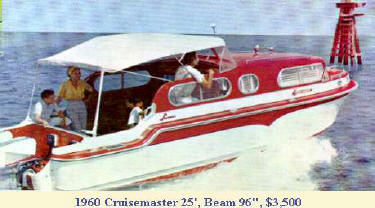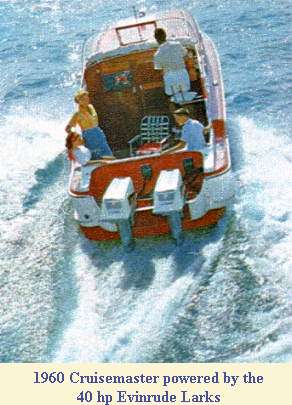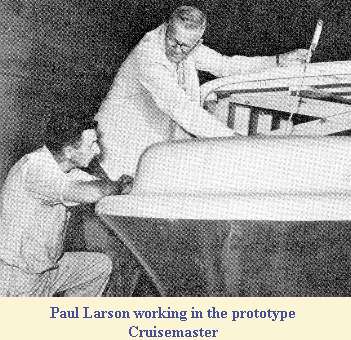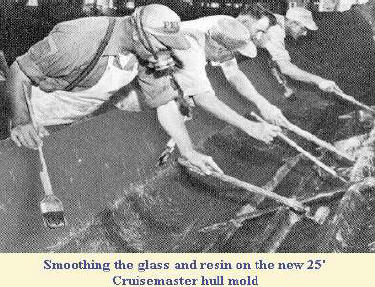By Lee Wangstad
It was shortly after Christmas, 1958 and the news that hit Little Falls would shake the little community down to its very soul. Paul Larson had been quietly developing a new boat that would take Larson Boat Works into a whole new arena. The boat was the Cruisemaster, a 25′ outboard powered flying bridge cruiser. But the boat in itself was not the startling news. The bombshell that hit the streets of Little Falls was that Paul Larson had received a very attractive offer of a building, complete with rail service, in the neighboring community of Staples where he could begin immediate production of this new cruiser. With the site of Larson’s plant on the east side of the Mississippi River completely landlocked, there was no place to expand their facility. In order to produce the cruiser, expansion was necessary. Their existing plant was already bursting at the seams, barely able to keep up with production of their current lines.
 Not willing to let go of any manufacturing jobs to another community, the civic and business leaders of Little Falls banded together and formed the Little Falls Industrial Development Corporation. Time was of the essence as Larson was hoping to begin operations of their Cruiser Division by the spring of 1959. With little time to raise the needed capital, the newly formed development company issued stock at $100 per share on January 13, 1959. By January 15th they had already received pledges on 374 shares and by the 16th, they went over 506 shares. With a construction budget of $60,000, they were nearing their goal in a hurry.
Not willing to let go of any manufacturing jobs to another community, the civic and business leaders of Little Falls banded together and formed the Little Falls Industrial Development Corporation. Time was of the essence as Larson was hoping to begin operations of their Cruiser Division by the spring of 1959. With little time to raise the needed capital, the newly formed development company issued stock at $100 per share on January 13, 1959. By January 15th they had already received pledges on 374 shares and by the 16th, they went over 506 shares. With a construction budget of $60,000, they were nearing their goal in a hurry.
While the funding drive was being sewn up, the city of Little Falls was preparing a site proposal on the west side of the river across from the existing plant. This site had been willed to the city in 1945 by R.D. Musser under the stipulation that it be used either as a park or for industrial use. It had rail service and covered over ten acres, which would be available for future expansion. This new site and facility would then be leased to Larson Boat Works for the sum of $6,000 per year for a fifteen year period.
 While all of this was going on, Paul Larson continued to work on the design and molds for this huge cruiser. With a beam of eight feet and a depth of 58 inches, this boat was definitely headed for big water. Never one to back off of an idea that might not be headed right down the center lane, Paul Larson felt that the market was ready.
While all of this was going on, Paul Larson continued to work on the design and molds for this huge cruiser. With a beam of eight feet and a depth of 58 inches, this boat was definitely headed for big water. Never one to back off of an idea that might not be headed right down the center lane, Paul Larson felt that the market was ready.
On February 4th, 1959, Paul Larson and his entourage loaded the Cruisemaster prototype along with nine other models, and headed off for its premier showing at the Chicago National Boat Show, held at Chicago’s Amphitheater.
While the sales team was out testing the waters for this new member of the Larson lineup, work had already begun back in Little Falls on the new plant. Paul Larson announced at the Chicago show that the new plant was only part of Larson’s nationwide expansion plans.
On April 22, 1959, the new 70′ x 200′ building was officially dedicated with Mrs. Leonard Sweeney, wife of the president of the Little Falls Development Corp., breaking a bottle of Mississippi River water over the bow of a new Cruisemaster.
 At the dedication ceremony, Paul Larson spoke to the crowd of officials and well-wishers that had gathered. “When I built my first boat 53 years ago,” said Larson, “even my fondest hopes did not foresee this present development.” He went on to thank the development corporation and also thanked “the people of Little Falls for their faith in the future of Larson and their own community.” He also made a special point of thanking his workmen for continuing to produce products that were winners in the marketplace.
At the dedication ceremony, Paul Larson spoke to the crowd of officials and well-wishers that had gathered. “When I built my first boat 53 years ago,” said Larson, “even my fondest hopes did not foresee this present development.” He went on to thank the development corporation and also thanked “the people of Little Falls for their faith in the future of Larson and their own community.” He also made a special point of thanking his workmen for continuing to produce products that were winners in the marketplace.
In the July 1959 issue of The Rudder, there was a special report on some of the larger boats that were being produced specifically for outboard power. The Cruisemaster was pictured with proud Larson executives out for a wide open test run on the Mississippi. It was stated that twenty-five had already been sold, with plans for building another hundred of the large cruisers in time for the 1959 season. This little bit of marketing hype would lead to one of the biggest mysteries surrounding Larson lore.
Back in Little Falls, the 1959 season was going completely out of control at Larson. They simply could not keep production running as fast as orders were coming in for their runabouts. Already running shifts around the clock at their existing facility, their new plant was put into runabout production, with plans underway for a January 1, 1960 production start for the Cruisemaster. They would have to be patient.
But the January 1st production date would never arrive for the Cruisemaster. On September 15, 1960 it was announced that Larson Boat Works had been sold to Brunswick Corporation. Brunswick had already purchased Owens Yacht Company of Baltimore. With Owens firmly established in the cruiser market, it made no sense in their marketing strategy for Larson to produce a cruiser of their own. Larson had been purchased strictly for their runabout lines.
 In all, there were two Cruisemasters built. The original prototype boat that went to the Chicago show, later went to the Miami Boat Show and was sold to a customer afterwards. The second boat was the one that was christened at the dedication of the new “Cruiser Division” plant. No one seems to remember its whereabouts or place of sale. Rumors persist that it cruised Lake Michigan, with Chicago its home port.
In all, there were two Cruisemasters built. The original prototype boat that went to the Chicago show, later went to the Miami Boat Show and was sold to a customer afterwards. The second boat was the one that was christened at the dedication of the new “Cruiser Division” plant. No one seems to remember its whereabouts or place of sale. Rumors persist that it cruised Lake Michigan, with Chicago its home port.
While some might see a production run of two boats as a failure, it must be placed in the context of the times and circumstances. When a community and work force can band together to produce a team willing to go all out for the common good, it can only lead to success.
The old “Cruiser Division Plant” is today the heart of the present Larson Boats manufacturing facility on the west bank of the Mississippi River. A visit to this plant today will rekindle the spirit of Paul Larson’s dream of a bigger boat for a broader market. It also begs for an answer as to the fate of these two Cruisemasters that embraced Little Falls’ dedication to Paul’s vision.

